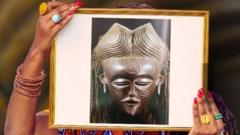An ancient writing system confounding myths about Africa has emerged as a focal point of discussion, particularly with the uncovering of various Zambian artifacts that illustrate the country's rich cultural heritage. A wooden toolbox belonging to hunters, inscribed with the seldom-used Sona writing system, has garnered attention online and challenged long-held misconceptions about African literacy. Samba Yonga, co-founder of the Women's History Museum of Zambia, emphasizes, "We've grown up being told that Africans didn't know how to read and write, but we had our own way of writing and transmitting knowledge that has been completely sidelined and overlooked."
This initiative is part of an online campaign aimed at highlighting women's contributions in pre-colonial societies while reclaiming cultural identities almost erased by colonial rule. The project showcases 50 significant objects, including an ornate leather cloak not seen in Zambia for more than a century, revealing that women played a vital role in historical belief systems and environmental understanding.
"The artefacts signify a history that matters— and a history that is largely unknown," Yonga remarked. Exploring themes of cultural disruption due to colonialism, she noted the increasing interest in reconnecting with heritage through various avenues, such as fashion and academia. As part of their efforts, the project utilizes social media to dispel the prevailing notion that African communities lacked their own knowledge systems.
Yonga's journey began in Sweden after encountering a wealth of Zambian cultural artifacts stored in museums, many of which remained underexplored. Among them are decorative fishing baskets, ceremonial masks, and 20 immaculate leather cloaks crafted from lechwe antelope hide, demonstrating the artistry and deep-rooted traditions of the Batwa people. However, the knowledge of these items’ cultural significance faded when intertwined with the colonial experience.
Sona, the intricate writing system of the Chokwe, Luchazi, and Luvale communities, uses geometric patterns that convey various messages, often featuring instructions on community life and environmental interactions. This writing tradition, successfully highlighted through social media, has astonished audiences worldwide and has become a celebrated symbol of African knowledge.
Reflecting on their discoveries, Yonga and her team found that shared community knowledge around certain artifacts, like the grinding stone used by women in the Tonga community, was strikingly significant. This stone was not just a kitchen tool; it served as a gravestone, illustrating the respect held for women's roles in food security.
The Women’s History Museum of Zambia was founded in 2016 to systematically document and archive women’s histories and indigenous knowledge. The ongoing quest for lost cultural pieces symbolizes a larger treasure hunt, fueled by a desire to understand historical identities and the interconnectedness of community bonds.
Through this engaging social media project, Yonga aims to change how individuals perceive their historical and cultural identities, ultimately fostering a deeper understanding of their roots and narratives.
This initiative is part of an online campaign aimed at highlighting women's contributions in pre-colonial societies while reclaiming cultural identities almost erased by colonial rule. The project showcases 50 significant objects, including an ornate leather cloak not seen in Zambia for more than a century, revealing that women played a vital role in historical belief systems and environmental understanding.
"The artefacts signify a history that matters— and a history that is largely unknown," Yonga remarked. Exploring themes of cultural disruption due to colonialism, she noted the increasing interest in reconnecting with heritage through various avenues, such as fashion and academia. As part of their efforts, the project utilizes social media to dispel the prevailing notion that African communities lacked their own knowledge systems.
Yonga's journey began in Sweden after encountering a wealth of Zambian cultural artifacts stored in museums, many of which remained underexplored. Among them are decorative fishing baskets, ceremonial masks, and 20 immaculate leather cloaks crafted from lechwe antelope hide, demonstrating the artistry and deep-rooted traditions of the Batwa people. However, the knowledge of these items’ cultural significance faded when intertwined with the colonial experience.
Sona, the intricate writing system of the Chokwe, Luchazi, and Luvale communities, uses geometric patterns that convey various messages, often featuring instructions on community life and environmental interactions. This writing tradition, successfully highlighted through social media, has astonished audiences worldwide and has become a celebrated symbol of African knowledge.
Reflecting on their discoveries, Yonga and her team found that shared community knowledge around certain artifacts, like the grinding stone used by women in the Tonga community, was strikingly significant. This stone was not just a kitchen tool; it served as a gravestone, illustrating the respect held for women's roles in food security.
The Women’s History Museum of Zambia was founded in 2016 to systematically document and archive women’s histories and indigenous knowledge. The ongoing quest for lost cultural pieces symbolizes a larger treasure hunt, fueled by a desire to understand historical identities and the interconnectedness of community bonds.
Through this engaging social media project, Yonga aims to change how individuals perceive their historical and cultural identities, ultimately fostering a deeper understanding of their roots and narratives.





















